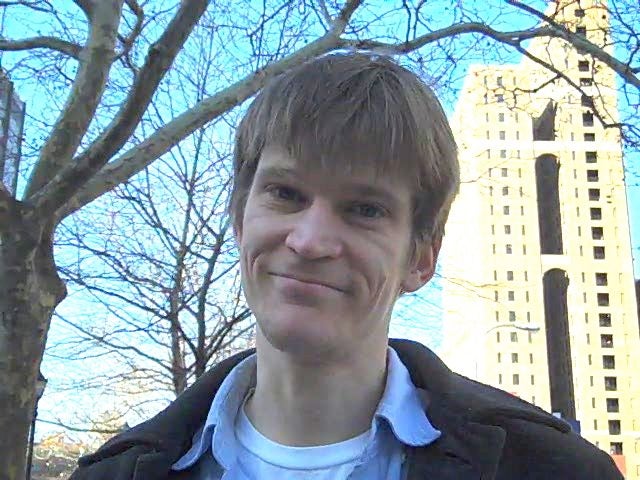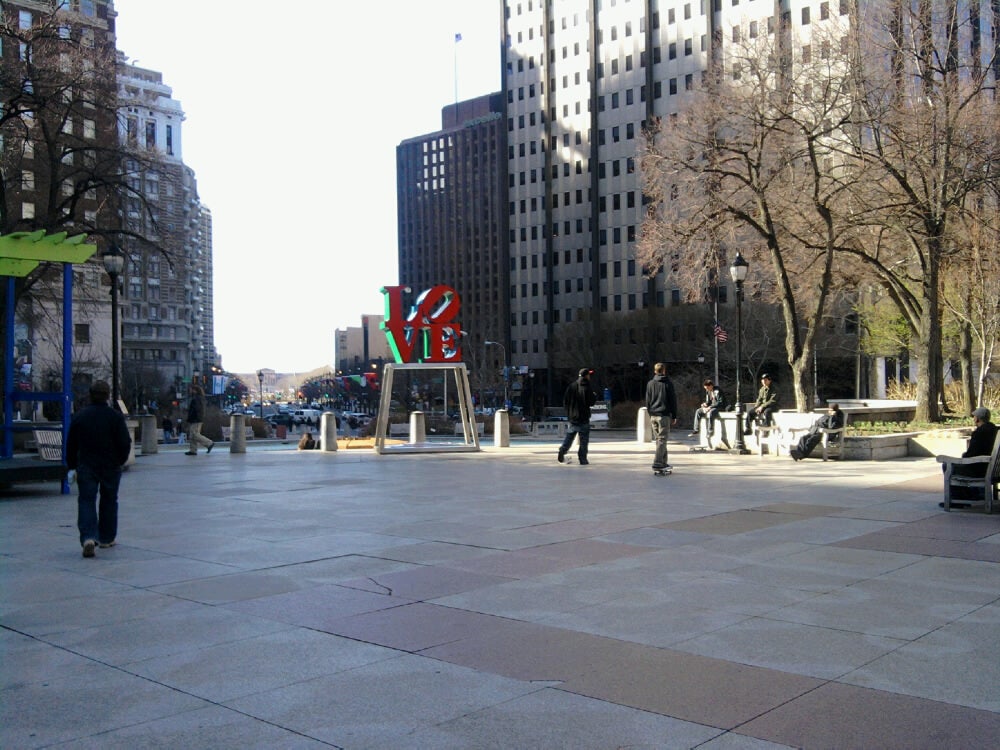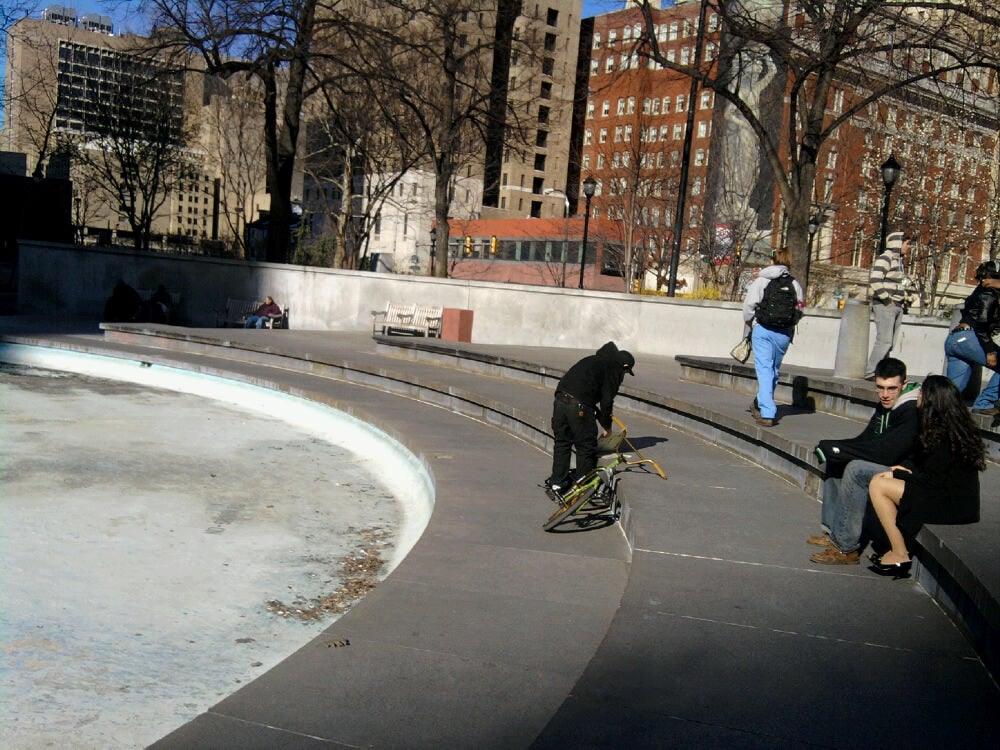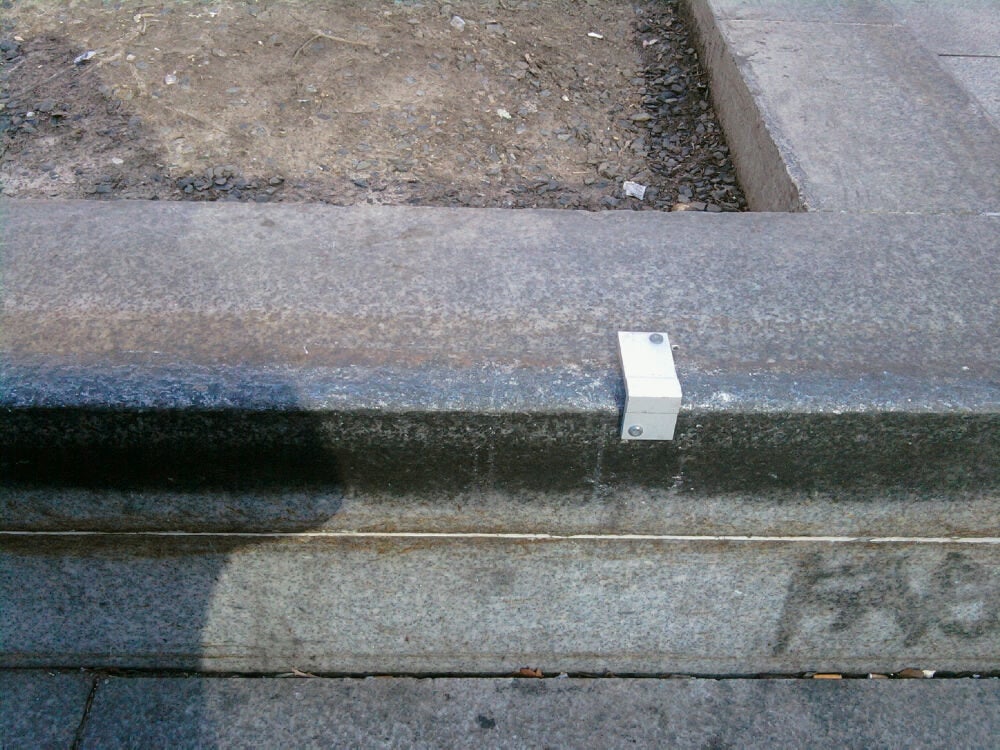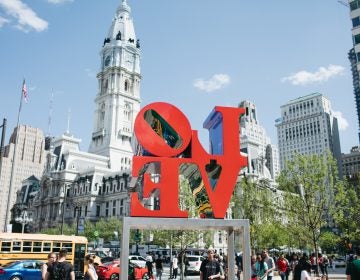Why Love Park works: a skateboarder’s point of view
On a sunny, chilly afternoon this week, a half-dozen young men, holding or riding skateboards, gathered in Love Park.
One rode his board in a diagonal line across the vast field of granite pavers. He jumped into the air and spun the board around, but didn’t manage to land back on it. His friend traced a similar path, jumping and spinning his board, and then landing successfully.
But this game of s-k-a-t-e – in which players whose tricks fail are out when they get all five letters– was never finished. The riders scattered at first sight of a bicycle cop.
Skateboarding at Love Park has been illegal for a long time. But neither that fact, nor the changes the city made to the park in 2002 with the addition of large pink planters and strips of grass, have stopped skateboarders from using the space. As the city prepares for another re-do of the Center City icon in conjunction with repairs on the garage that lies beneath it, PlanPhilly spent a couple hours with long-time skateboarder and skateboard advocate Scott Kip to learn more about the attraction.
Here’s what Kip, a 36-year-old restoration carpenter who in 2003 helped found the Skateboard Advocacy Network, had to say, in words and video.
Love Park’s surface charms
“This is Granite Wonderland,” Kip says before leaving Centre Square and crossing JFK Boulevard and into Love Park. He points out the stone-paved surfaces not only of Love Park ahead of him, but Dilworth Plaza around City Hall (which is also headed for a renovation) and the Municipal Services Building across 15th Street from the park.
The big swath of large granite squares are among the most basic reasons boarders like the park, Kip says. This is before the police officer rode by, and as one young man, board beneath his arm, walks past, Kip stops him and asks him to explain the allure of the surface.
“It’s smooth,” he says. “You can do anything here – your tricks pop high. And it makes your board last longer. It doesn’t rip it up like that sidewalk you see right there.”
The Top and The Levels
To skateboarders, the park is divided into two parts: The Top is the flat portion closest to City Hall. In addition to providing a lot of hard, flat surface to try different things, it also offers a series of ledges on which skateboarders can demonstrate their skills. The row of ledges allows a skateboarder to demonstrate consistency as he or she does moves again and again, Kip said.
The Levels are the stepped surfaces that circle the fountain. “It’s a great spot for skateboarding, almost as if it was designed for skateboarding,” Kip said. “It’s also like it was made to document skateboarding. A person with a camera can roll along on a lower level and film someone on an upper level.”
Just as baseball has right-handed and left-handed hitters and pitchers, skateboarders favor either their right or left foot forward. Most people skate with their left foot forward. Those – like Kip – who skate with the right forward are said to be goofy footed.
Goofy-footed, Love Gap and the ledges
Love Park works equally well for both kinds of skaters, because some of the ledges break to the right, and some break to the left. Likewise, the park offers good boarding opportunities for everyone from novice to professional, Kip said.
Skateboarders make a name for themselves – and build professional careers if they are especially skillful and lucky – by publishing videos of themselves performing difficult moves. Love Park is such a significant venue to the skating community that it is immediately recognizable in these videos, Kip said.
Skaters come to see where boarder Kerry Getz kick-flipped the Love Gap – where he jumped off of his board at The Top, flipping it in the air, then landing on it again in the dry fountain bed. Jumping the gap is among the “more macho” tricks that the park offers, Kip said. “Kids from out of town look and say, ‘My God, how did he do that?’ Or ‘I think I can do that!'”. Just like golfers measuring their skills by comparing their performance to others on a top-notch, famous course, skaters can test their mettle at Love Park, he said.
Love Park could physically be replicated somewhere else, and skaters would go, Kip said, but it would not be the same. This is the place where skating history has been made, he said. And the location in the heart of the city means “You’re a participant in this city when you come here to skate.”
Love Park: The iconic place to skate
A group of city agencies have studied the park, and their work resulted in a request for proposals floated by the parking authority in search of a designer. Some elements of the park are iron-clad: The diagonal view down the parkway must be preserved. The Love statue must go right back where it is now. The garden areas will stay. The edges of the park will be brought down to street level. But other elements will be determined by the designer, who has not yet been selected from the applicants who applied prior to the February deadline. There will be public comment taken, but there is no plan to legalize skateboarding at the park. The city’s position continues to be that skateboarding causes damage to surfaces and is incompatible with other uses.
But Kip – and other boarders and supporters – haven’t changed their position, either. They think the city is making a mistake. “You’re ignoring major users of the park,” Kip said.
The Scene
Kip believes changes in design – such as using darker surfaces that will not show marks left from wax as readily – setting after-work hours for skating when no one wants to eat lunch in the park, and making some portions of the park skate-free at all times, could appease everyone. “There’s design solutions to everything,” he said. “I think there’s no legitimate reason why they shouldn’t explore them.”
Kip calls for design solutions instead of exclusion. See another skating spot that he says shows one possible solution here.
Outside Love Park, Kip pointed out the base of the John Wanamaker statue at City Hall as a place that boarders like to stop and test their skill. The statue is immediately surrounded by a square of rough pavers that are not skateboard friendly, but the area beyond that is amenable, and so skateboarders like to go fast approaching the statue, jump up with the board clinging to their feet and land on the base, and then jump down and land, board and all, where the smooth surface resumes on the other side.
At the Wanamaker statue
They jump across the statue, from Wanamaker’s right hand to his left, or vice versa, Kip said. But the granite has chunks missing the whole way around. Sometimes, things just wear out, he said. “You can’t blame everything on skateboarders.”
Reach the reporter at kgates@planphilly.com.
WHYY is your source for fact-based, in-depth journalism and information. As a nonprofit organization, we rely on financial support from readers like you. Please give today.



